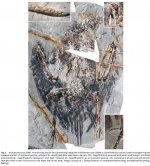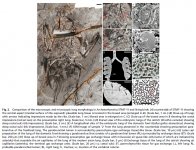Fred Ruhe
Well-known member

Archaeorhynchus lungs preserved?
This information comes from the Society for Vertebrate Paleontology meeting 2018 in Albuquerque:
http://vertpaleo.org/Annual-Meeting...rogram-book-V4-FINAL-with-covers-9-24-18.aspx
pg. 192:
A SPECIMEN OF ARCHAEORHYNCHUS PRESERVING SIGNIFICANT SOFT TISSUE INCLUDING THE FIRST PROBABLE OCCURRENCE OF FOSSILIZED LUNGS
O'CONNOR, Jingmai, Institute of Vertebrate Paleontology & Paleoanthropology, Beijing, China; MAINA, John, Johannesburg, South Africa; PAN, Yanhong, Nanjing, China; WANG, Min, Institute of Vertebrate Paleontology & Paleoanthropology, Beijing, China; WANG, Xiaoli, Linyi University, Lingyi, China; WANG, Yan, Linyi University, Lingyi, China; ZHENG, Xiaoting, Linyi University, Lingyi, China; ZHOU, Zhonghe, Institute of Vertebrate Paleontology and Paleoanthropology, Beijing, China
We describe a new specimen of the basal ornithuromorph Archaeorhynchus spathula from the Lower Cretaceous Jiufotang Formation with extensive soft tissue preservation. Although it is the fifth specimen to be described, it is the first to preserve significant traces of the plumage, revealing a pin-tail morphology previously unrecognized among Mesozoic birds but common in extant neornithines. In addition, this specimen preserves the probable remnants of the paired lungs, an identification supported by topographical and macro- and microscopic anatomical observations. The preserved morphology reveals a lung very similar to that of living birds. It indicates that pulmonary specializations such as exceedingly subdivided parenchyma that allow birds to achieve the oxygen acquisition capacity necessary to support powered flight were present in ornithuromorph birds 128 Ma. This is the first documented occurrence of preserved lung soft tissue in a fossil vertebrate Among extant air breathing vertebrates, birds have structurally the most complex and functionally the most efficient respiratory system, which facilitates their highly energetically demanding form of locomotion even in extremely oxygen poor environments. Archaeorhynchus is commonly resolved as the most basal known ornithuromorph bird, capturing a stage of avian evolution in which skeletal indicators of respiration remain primitive yet the lung microstructure appears modern. This adds to growing evidence that many physiological modifications of soft tissue systems (e.g., digestive system and respiratory system) that characterize living birds and are key to their current success may have preceded the evolution of obvious skeletal adaptations traditionally tracked through the fossil record.
Grant Information
National Natural Science Foundation of China (41688103, 41472023, 41372014, 41402017)
News
https://www.sciencenews.org/article/first-scientists-spot-what-may-be-lungs-ancient-bird-fossil
https://www.livescience.com/63880-oldest-fossil-bird-lung.html
Enjoy,
Fred
This information comes from the Society for Vertebrate Paleontology meeting 2018 in Albuquerque:
http://vertpaleo.org/Annual-Meeting...rogram-book-V4-FINAL-with-covers-9-24-18.aspx
pg. 192:
A SPECIMEN OF ARCHAEORHYNCHUS PRESERVING SIGNIFICANT SOFT TISSUE INCLUDING THE FIRST PROBABLE OCCURRENCE OF FOSSILIZED LUNGS
O'CONNOR, Jingmai, Institute of Vertebrate Paleontology & Paleoanthropology, Beijing, China; MAINA, John, Johannesburg, South Africa; PAN, Yanhong, Nanjing, China; WANG, Min, Institute of Vertebrate Paleontology & Paleoanthropology, Beijing, China; WANG, Xiaoli, Linyi University, Lingyi, China; WANG, Yan, Linyi University, Lingyi, China; ZHENG, Xiaoting, Linyi University, Lingyi, China; ZHOU, Zhonghe, Institute of Vertebrate Paleontology and Paleoanthropology, Beijing, China
We describe a new specimen of the basal ornithuromorph Archaeorhynchus spathula from the Lower Cretaceous Jiufotang Formation with extensive soft tissue preservation. Although it is the fifth specimen to be described, it is the first to preserve significant traces of the plumage, revealing a pin-tail morphology previously unrecognized among Mesozoic birds but common in extant neornithines. In addition, this specimen preserves the probable remnants of the paired lungs, an identification supported by topographical and macro- and microscopic anatomical observations. The preserved morphology reveals a lung very similar to that of living birds. It indicates that pulmonary specializations such as exceedingly subdivided parenchyma that allow birds to achieve the oxygen acquisition capacity necessary to support powered flight were present in ornithuromorph birds 128 Ma. This is the first documented occurrence of preserved lung soft tissue in a fossil vertebrate Among extant air breathing vertebrates, birds have structurally the most complex and functionally the most efficient respiratory system, which facilitates their highly energetically demanding form of locomotion even in extremely oxygen poor environments. Archaeorhynchus is commonly resolved as the most basal known ornithuromorph bird, capturing a stage of avian evolution in which skeletal indicators of respiration remain primitive yet the lung microstructure appears modern. This adds to growing evidence that many physiological modifications of soft tissue systems (e.g., digestive system and respiratory system) that characterize living birds and are key to their current success may have preceded the evolution of obvious skeletal adaptations traditionally tracked through the fossil record.
Grant Information
National Natural Science Foundation of China (41688103, 41472023, 41372014, 41402017)
News
https://www.sciencenews.org/article/first-scientists-spot-what-may-be-lungs-ancient-bird-fossil
https://www.livescience.com/63880-oldest-fossil-bird-lung.html
Enjoy,
Fred





